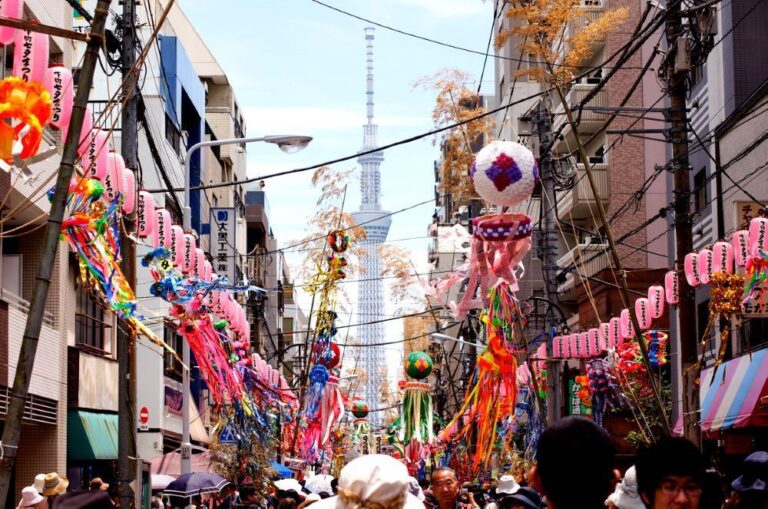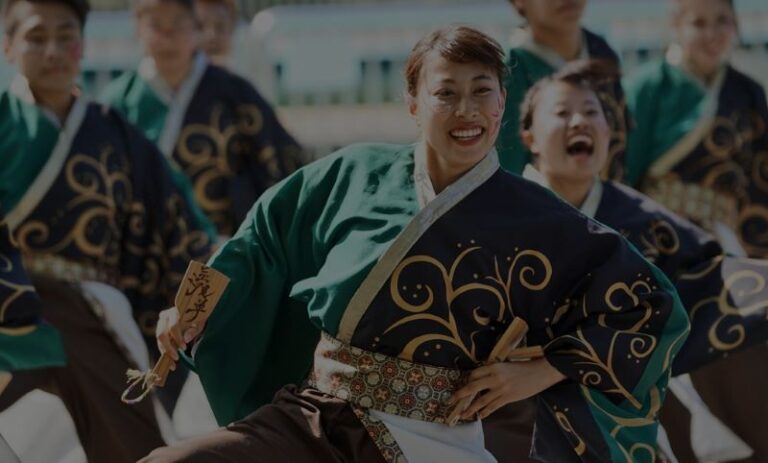The Some no Komichi Dyeing Festival in Tokyo is an annual celebration of traditional Japanese dyeing techniques. This festival showcases unique artisanal creations and features vibrant strips of fabric strung above the Myoshoji River.

With its origins in the dye producers’ practice of hanging fabric along the river, the festival pays homage to the Japanese fabric dyeing tradition. Tokyo, Kyoto, and Kanazawa have been significant centers for dyed fabric production, with master dyers establishing workshops along the Myoshoji River.
The festival highlights the art and techniques of these remaining master dyers, offering visitors a chance to immerse themselves in the rich cultural heritage of Japanese fabric dyeing.
Key Takeaways
- Some no Komichi Dyeing Festival is an annual celebration of traditional Japanese dyeing techniques held in Tokyo in February.
- The festival showcases unique artisanal creations and features spectacular strips of colorful fabric strung above the Myoshoji River, attracting thousands of visitors each year.
- The festival celebrates the Japanese fabric dyeing tradition, which originated from dye producers hanging their fabric along the Myoshoji River, creating a mesmerizing river gallery of dyed fabrics that reflect delightful hues off the water.
- The festival serves as a platform to showcase the art and techniques of the remaining traditional dye houses in the area, as well as offering hands-on artistic fabric dyeing workshops and a Nakai Treasure Hunt for visitors to explore the old-fashioned residential area.
What is it?
The Some no Komichi Dyeing Festival is an annual celebration held in Tokyo in February that showcases the traditional Japanese dyeing techniques through the display of unique artisanal creations.
One of the main attractions of the festival is the strips of colorful fabric that are strung above the Myoshoji River, creating a mesmerizing sight for visitors.
This festival has been able to attract thousands of visitors each year, who come to witness the beauty and skill of Japanese dyeing techniques.
The festival not only serves as a platform to showcase the artistry of traditional dyeing, but also contributes to the revitalization of Japan’s dyeing traditions.
Celebration of Dyeing Techniques
Celebration of dyeing techniques is a prominent aspect of the annual event. The Some no Komichi Dyeing Festival in Tokyo brings together artisans and enthusiasts to showcase and honor Japan’s rich fabric dyeing tradition.
The festival pays homage to the historical practice of hanging dyed fabrics along the Myoshoji River, creating a captivating gallery of colors that reflect off the water. This celebration not only highlights the artistry and craftsmanship of the dyeing process but also serves as a platform for the remaining traditional dye houses in the area to showcase their unique techniques.
Visitors to the festival can witness demonstrations by master dyers, participate in hands-on workshops, and appreciate the stunning array of dyed fabrics on display.
The celebration of dyeing techniques at the Some no Komichi Dyeing Festival is a testament to the cultural significance and enduring legacy of Japan’s dyeing traditions.
Transformation Journey
Tokyo, Kyoto, and Kanazawa have historically served as significant centers for the production of dyed fabrics, with master dyers establishing workshops along the Myoshoji River. These workshops were vital to the growth and development of the craft, as they provided a space for the exchange of knowledge and techniques.
For many years, around 300 master dyers utilized the river, creating a vibrant and bustling community. However, as time went on, the industry faced challenges and the number of active dyers declined. Despite this, a dozen traditional dye houses remain active in the area, keeping the spirit of the craft alive.
The Some no Komichi festival serves as a platform to showcase the art and techniques of these master dyers, allowing visitors to witness the transformation journey of this ancient craft. It is a celebration of their dedication and passion, and a testament to the resilience of traditional Japanese dyeing traditions.
Nakai Treasure Hunt
Nakai Treasure Hunt offers visitors a unique experience by providing them with a map to find 90 noren curtains, guiding them through small restaurants and local facilities in an old-fashioned residential area. This treasure hunt not only engages participants in a thrilling quest, but also immerses them in the rich cultural heritage of Japan’s dyeing traditions.
As visitors venture through the narrow streets, they encounter a blend of tradition and modernity, with traditional Japanese sword fights and other attractions adding to the excitement. Plus, participants have the opportunity to engage in hands-on artistic fabric dyeing workshops at self-managed studios, allowing them to experience the intricate craftsmanship involved in dyeing techniques firsthand.
The Nakai Treasure Hunt encapsulates the spirit of freedom, enabling visitors to explore and appreciate the beauty of Japan’s dyeing traditions in a fun and engaging manner.
Cultural Revitalization
Cultural revitalization in Ochiai encompasses various aspects such as the Saeki Yuzo and Nakamura Tsune museums housing paintings by famous Japanese painters, the European modernism influence on Yôga style, and the mesmerizing spaces for contemplation found at Goryo Shrine and Kongo-ji.
- Saeki Yuzo and Nakamura Tsune museums: These museums are home to a vast collection of paintings by renowned Japanese artists, providing visitors with an opportunity to immerse themselves in the rich artistic heritage of Japan.
- European modernism influence on Yôga style: The Yôga style of painting in Japan experienced a significant transformation with the introduction of European modernism. This fusion of Eastern and Western artistic influences resulted in the creation of unique and captivating artworks.
- Goryo Shrine and Kongo-ji: These sacred spaces offer a serene and tranquil environment for contemplation. Visitors can find solace amidst the beautifully landscaped gardens, intricate architecture, and the spiritual aura that permeates these shrines.
Through these cultural elements, Ochiai not only preserves its artistic legacy but also provides a platform for the audience to appreciate and engage with the freedom of expression that art offers.
Frequently Asked Questions
How long has the Some no Komichi Dyeing Festival been taking place in Tokyo?
The Some no Komichi Dyeing Festival has been taking place in Tokyo for an undisclosed number of years. It is an annual celebration of traditional Japanese dyeing techniques, showcasing unique artisanal creations.
How many visitors attend the Some no Komichi Dyeing Festival each year?
The Some no Komichi Dyeing Festival attracts thousands of visitors each year. This annual celebration showcases traditional Japanese dyeing techniques and features a mesmerizing display of colorful fabrics hung above the Myoshoji River in Tokyo.
What is the significance of the Myoshoji River in the dyeing tradition?
The Myoshoji River holds great significance in the dyeing tradition as it was traditionally used by dye producers to hang their fabric, creating a mesmerizing river gallery of dyed fabrics that reflected delightful hues off the water.
How many traditional dye houses are still active in the Some no Komichi area?
There are a dozen traditional dye houses that are still active in the Some no Komichi area. These houses showcase their art and techniques during the festival, preserving and celebrating the Japanese fabric dyeing tradition.
What other attractions are there in Ochiai apart from the dyeing festival?
Apart from the dyeing festival, Ochiai offers cultural attractions such as the Saeki Yuzo and Nakamura Tsune museums, showcasing paintings by famous Japanese artists. Goryo Shrine and Kongo-ji provide spaces for contemplation, and tranquil parks display spring flowers. Plus, visitors can enjoy delicious meals at reasonable prices.
The Sum Up
To sum it up, the Some no Komichi Dyeing Festival in Tokyo is a captivating celebration of traditional Japanese dyeing techniques. This annual event not only showcases the unique creations of master dyers but also pays homage to the rich history and cultural significance of fabric dyeing in Japan.
By reviving and preserving these dyeing traditions, the festival not only attracts thousands of visitors but also contributes to the cultural revitalization of the Ochiai area.
Through workshops, treasure hunts, and immersive experiences, the festival allows visitors to immerse themselves in the vibrant world of Japanese fabric dyeing.



